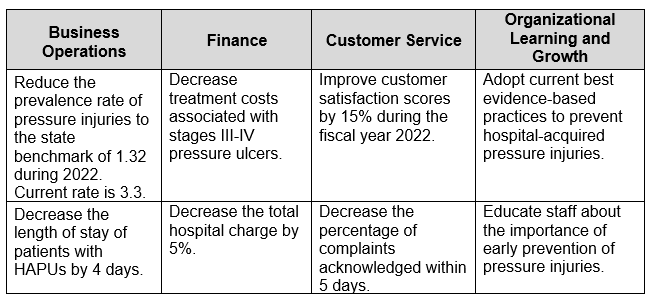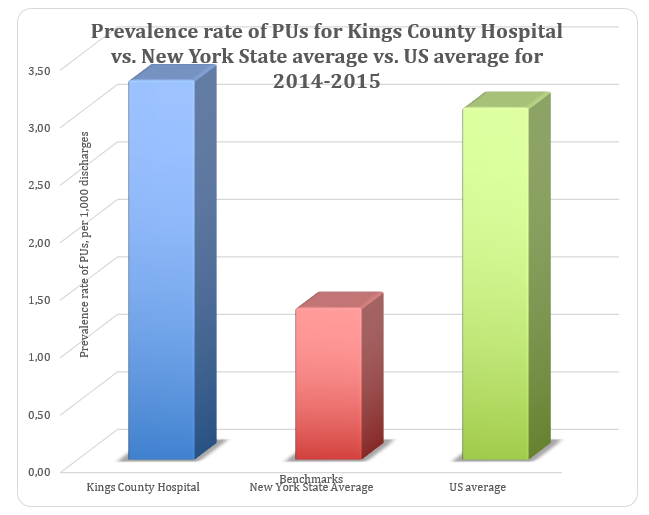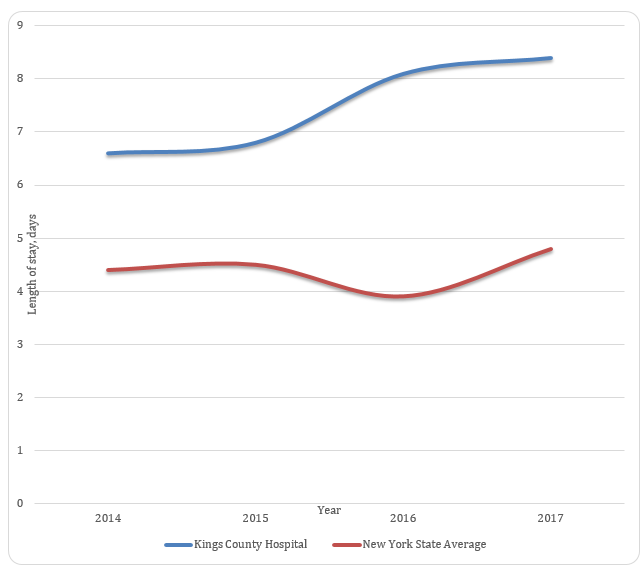Executive Summary
The topic of the project is hospital-acquired pressure ulcers (HAPUs) in healthcare organizations in the United States. The problem of the project is the alarming prevalence rates of HAPUs in Kings County Hospital Center in comparison with the benchmark set by the New York State Department of Health. Kings County Hospital Center has a 3.3 PU rate during October 2014 ? October 2015, as compared to the state benchmark of 1.32 (New York State Department of Health, 2016). Since this condition places an enormous physical and economic burden on patients who suffer from permanent pain and is a critical patient safety indicator, it is important to study the identified project problem to help the organization make a difference for patients and their families attempting to address this issue.
The purpose of the project is to get a clear understanding of the differences in the HAPU rates between Kings County Hospital Center and the New York State average. In order to study the nature and the extent of these differences, the data review of the two databases will be performed. The collected raw data will be further used to make conclusions regarding the occurrence of pressure injuries in Kings County Hospital Center in the form of appropriate visualizations. Based on the obtained results, areas for quality improvement will be outlined, and specific recommendations relying on the current best evidence-based practices will be given. The nature of the project findings is the quality improvement of prevalence rates of HAPUs in Kings County Hospital Center and enhanced patient care.
Introduction
I am examining the prevalence rates of HAPUs because prevention of this condition is viewed as the critical patient safety indicator and a top priority of the majority of the US healthcare organizations (Clark et al., 2014). I will examine the rates of HAPUs in Kings County Hospital Center and assess the data by measuring the incidence and prevalence rates of pressure injuries, the length of hospital stay, as well as decreases in the incidence and prevalence rates of category 2, 3, and 4 pressure ulcers and a decrease in the length of hospital stay.
This project will add value to Kings County Hospital Center by giving some recommendations as to how to enhance patient care since its safety and quality is the hospital’s mission. This project aligns with my professional interests and future career goals by providing me with the opportunity to lead in exploring and assessing a real-world healthcare problem of pressure injuries in the healthcare setting.
Background
Poor quality of care and a lack of nursing staff make the incidence and prevalence rates of HAPUs grow. According to the quantitative research study, the incidence rate of pressure injuries currently stands at 30% per thousand discharges (Pickham et al., 2018, p. 13). Another quantitative research study found that such an alarming percentage may be explained by the utilization of protocols that are not guided by the best evidence-based practices and high costs of adoption of appropriate technological equipment, such as support surfaces or wearable patient sensors (Kwong, Lee, & Yeung, 2016).
When examining the literature on the current strategies used for HAPU prevention, Wilborn (2015) mentioned that patients who develop pressure injuries in the hospital setting are linked with higher mortality rates and longer length of stay. The authors of a network meta-analysis found that more than 60,000 patients die annually due to complications of the condition (Shi, Dumville, & Cullum, 2018, p. 2). These statistics highlight the need for a critical assessment of the performance of a single hospital-based on the set benchmark in order to evaluate how effectively it tackles the chosen practice problem.
It is worth mentioning that pressure injuries are associated with serious economic concerns. It was highlighted in the study with a cost-utility analysis that HAPUs cost the US healthcare system an estimated $9-11 billion annually (Padula et al., 2018, p. 133). However, as was found by the authors of the qualitative descriptive research, apart from costs related to treatment, HAPUs may also result in litigation (Roberts et al., 2017). Considering the discontinuation of reimbursement for HAPUs, enormous stress is placed on hospitals to prevent the incidence of this costly condition, not to mention daunting financial implications for patients.
Client Value Proposition
While the project does not propose the implementation of the current evidence-based practice that has a protective effect against the development of HAPUs, it outlines the ongoing issues which the hospital faces in relation to the prevention of pressure injuries. Table 1 shows how the project will add value to business operations, finance, customer service, and organizational learning and growth areas. Since the hospital’s mission is to provide high-quality patient care, and its vision is to be the hospital of choice for customers, a better understanding of the scope of the practice problem of HAPUs will help the organization serve its patients better.

Prevalence rates of HAPUs in Kings County Hospital Center are 1.5 half times greater than the state average. The project not only highlights this problem and evaluates its scope but also provides insight into the areas on which the organization has to focus on. Speaking of the business operations, it is crucial that Kings County Hospital Center put much effort into improving such performance indicators as the prevalence rate of PUs and the length of stay of patients with this condition. One may assume that expenses incurred by the hospital have grown significantly since the government discontinued reimbursement for HAPUs (Kwong et al., 2016). If the organization concentrates on the improvement of alarming rates of HAPUs, it may enhance its financial position as treatment costs associated with PUs and the total hospital charge will be reduced. The financial burden placed on patients will also be reduced, which, to some extent, will increase their satisfaction with the services delivered.
I request input and feedback from the practicing health care professional to ensure that my identification of key performance indicators and targeted datasets under investigation align with the needs of the organization chosen.
Expected Outcomes and Precise Performance Measurement
Data collected from the New York State Department of Health and Kings County Hospital Center databases will be reviewed and analyzed. Such key performance indicators as the prevalence and incidence rates of stage 2, 3, and 4 pressure injuries and the length of stay of patients with stages 3 and 4 of HAPUs will be considered. The prevalence rate will be measured as the observed number of pressure ulcers per 1,000 patients. The incidence rate will be measured as the number of newly developed PUs per 1,000 patients. The length of stay will be measured as the sum of inpatient days. Outcome measures will be calculated as
- the difference between the average PU rate for New York and the hospital’s PU rate and
- the difference between the state average length of stay associated with HAPUs and the average length of stay for the selected hospital.
To summarize and compare the data, a bar graph will be built (see Figure 1). To show how the key performance indicators changed over the last three years, line graphs will be built (see Figure 2).


Leadership Component
I will be responsible for exploring the practice problem of pressure injuries by examining two databases and making conclusions from which the organization may benefit. I will also be responsible for the feasibility of the project design, accuracy of the project findings, their appropriate visualization, and relevance to Kings County Hospital Center. I play the primary role in the data review project and am responsible for its successful completion.
I think that my main role will be that of a leader as I am expected to be not only a healthcare researcher but also the initiator of leading a change. As a leader, I will be involved in critical decision-making based on quantitative data, including the organization’s key performance indicators and outcome measures. To me, this project is a unique opportunity to enhance my visibility and demonstrate leadership competencies.
Within the domain of People, I will practice change leadership by reflecting upon what the organization needs to do in order to decrease the high rates of HAPUs. Recommendations that will be given at the end of this project will align with the hospital’s mission and vision, as well as the best evidence-based practices. Within the domain of Transformation, I will practice strategic orientation by making a balanced scorecard that shows how the four areas of the organization will benefit from my data review project. In other words, I will enhance my ability to link the analytical part of the project with the organization’s values and strategic goals. Within the domain of Execution, I will practice performance measurement by identifying and estimating key performance indicators and outcome measures.
Timeline
A week-by-week summary of the main tasks is presented in Table 2.

References
Clark, M., Black, J., Alves, P., Brindle, C., Call, E., Dealey, C., & Santamaria, N. (2014). A systematic review of the use of prophylactic dressings in the prevention of pressure ulcers. International Wound Journal, 11(5), 460-471.
Kwong, E. W., Lee, P. H., & Yeung, K. (2016). Study protocol of a cluster randomized controlled trial evaluating the efficacy of a comprehensive pressure ulcer prevention programme for private for-profit nursing homes. BMC Geriatrics, 16(1), 20-27.
New York State Department of Health. (2016). Pressure ulcer. Web.
Padula, W. V., Pronovost, P. J., Makic, M. B. F., Wald, H. L., Moran, D., Mishra, M. K., & Meltzer, D. O. (2018). Value of hospital resources for effective pressure injury prevention: A cost-effectiveness analysis. BMJ Quality & Safety, 28(2), 132-141.
Pickham, D., Berte, N., Pihulic, M., Valdez, A., Mayer, B., & Desai, M. (2018). Effect of a wearable patient sensor on care delivery for preventing pressure injuries in acutely ill adults: A pragmatic randomized clinical trial (LS-HAPI study). International Journal of Nursing Studies, 80, 12-19.
Roberts, S., Wallis, M., Mcinnes, E., Bucknall, T., Banks, M., Ball, L., & Chaboyer, W. (2017). Patients’ perceptions of a pressure ulcer prevention care bundle in hospital: A qualitative descriptive study to guide evidence-based practice. Worldviews on Evidence-Based Nursing, 14(5), 385-393.
Shi, C., Dumville, J. C., & Cullum, N. (2018). Support surfaces for pressure ulcer prevention: A network meta-analysis. PLOS One, 13(2), 1-29.
Wilborn, W. (2015). Pressure ulcer prevention strategies. Nursing Made Incredibly Easy, 13(6), 10?12.